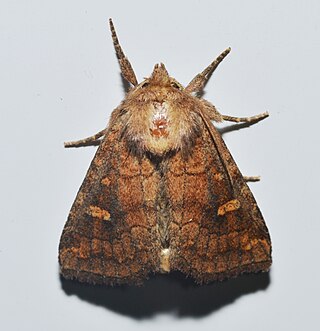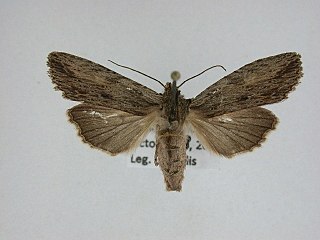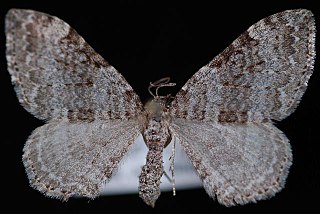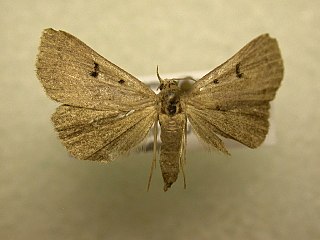
The southern scurfy Quaker moth is a moth of the family Noctuidae. It was formerly classified as a subspecies of Homorthodes furfurata. It is found in North America, from New Jersey, as far south east as Oklahoma.

Tricholita signata, the signate Quaker, is a moth in the family Noctuidae described by Francis Walker in 1860. It is found in North America.
Erastria coloraria, the broad-lined erastria, is a species of moth in the family Geometridae, in the superfamily Geometroidea. The species was described by Johan Christian Fabricius in 1798. It is found in North America.
Nemoria rubrifrontaria, the red-fronted emerald, is a species of moth in the family Geometridae, in the superfamily Geometroidea. The species was described by Alpheus Spring Packard in 1873. It is found in North America.
Tarache terminimaculata, the curve-lined bird-dropping moth, is a species of moth in the family Noctuidae. The species was described by Augustus Radcliffe Grote in 1873. It is found in North America.

Helotropha reniformis, the reniform celaena, is a species of moth in the family Noctuidae. The species was described by Augustus Radcliffe Grote in 1874. It is found in North America.

Copablepharon canariana is a species of moth in the family Noctuidae. The species was described by James Halliday McDunnough in 1932. It is found in North America.

Lithophane signosa, the signate pinion or sycamore pinion moth, is a species of moth in the family Noctuidae. The species was described by Francis Walker in 1857. It is found in North America.
Plagiomimicus aureolum is a species of moth in the family Noctuidae. It was described by Henry Edwards in 1882 and is found in North America, where it has been recorded from Arizona, western Texas and New Mexico.
Parabagrotis cupidissima is a species of moth in the family Noctuidae. It was described by Augustus Radcliffe Grote in 1875 and is found in North America, where it ranges from southern Vancouver Island, along the Pacific Coast states, to southern California. The habitat consists of grasslands and oak woodlands.
Meganola varia is a species of moth in the family Nolidae and superfamily Noctuoidea. The species was first described by William Barnes and Arthur Ward Lindsey in 1921. It is found naturally in North America, where it has been recorded throughout Arizona, New Mexico, and western Texas. While some moths of its species have reportedly been photographed in California, Meganola varia is not found on the California Moth Checklist.

Properigea niveirena is a species of moth in the family Noctuidae. It was described by Leon F. Harvey in 1876 and is found in North America, where it ranges from Vancouver Island, through western British Columbia, Washington and Oregon south to California and the border with Mexico, then east to New Mexico through southern Arizona.
Pero radiosaria is a species of moth in the family Geometridae. It was described by George Duryea Hulst in 1886 and is found in North America, where it has been recorded from southern California to Texas.

Xanthorhoe macdunnoughi is a species of moth in the family Geometridae. It was first described by Louis W. Swett in 1918 and is found in North America, where it has been recorded from open wooded areas in western North America, ranging east to western Alberta and south to California.

Bleptina inferior, the inferior owlet moth, is a species of moth in the family Erebidae. It was described by Augustus Radcliffe Grote in 1872 and is found in North America, where it has been recorded from Iowa to Massachusetts, south to Texas and Florida.

Metalectra quadrisignata, the four-spotted fungus moth, is a species of moth in the family Erebidae. It is found in North America, where it has been recorded from Arizona, Florida, Georgia, Indiana, Iowa, Kentucky, Louisiana, Maine, Maryland, Massachusetts, Michigan, New Brunswick, New Hampshire, New Jersey, North Carolina, Ohio, Oklahoma, Pennsylvania, Quebec, South Carolina, Tennessee, Texas, Virginia, West Virginia and Wisconsin. The species was described by Francis Walker in 1858.
Homorthodes dubia is a species of cutworm or dart moth in the family Noctuidae. It was described by William Barnes and James Halliday McDunnough in 1912 and is found in North America.
Homorthodes reliqua is a species of cutworm or dart moth in the family Noctuidae. It is found in North America.
Homorthodes gigantoides is a species of cutworm or dart moth in the family Noctuidae first described by William Barnes and James Halliday McDunnough in 1912. It is found in North America.

Homorthodes hanhami is a species of cutworm or dart moth in the family Noctuidae first described by William Barnes and James Halliday McDunnough in 1911. It is found in North America.










